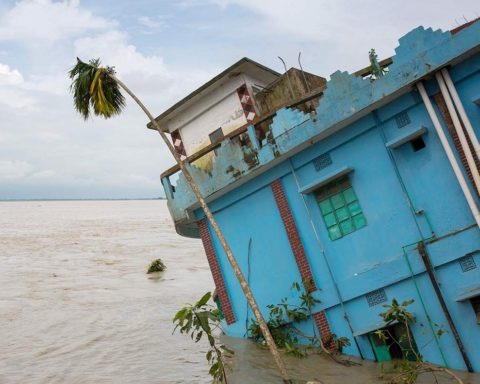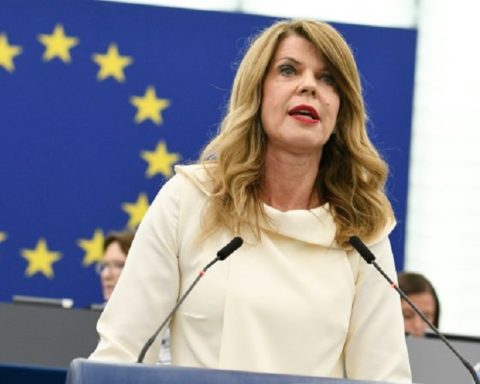This April 17, is launched the online consultation on new wealth indicators. France Stratégie and the Economic, Social and Environmental Council (EESC) are organising this process in the framework of the Eva Sas Law, published in the Official Journal on Tuesday 14 April 2015. The Member of Parliament (EELV) for Essonne, who is promoting this new "thermometer" of the progress of our societies, was the guest speaker at the round table on "Can indicators that complement GDP change public action? "organised by France Stratégie as part of Printemps de l'économie (13-17 April 2015). Explanations.
Qhat's a good company? Is it a society that improves life expectancy? Does it reduce income inequality? Who reduces its ecological footprint? Who continues to invest in the future? Who is improving their level of education? Who provides access to decent housing for all? All these questions are at the heart of the social dialogue that must come to clarify the priorities of the French to signify their quality of life. It is the Sas Law, adopted on 2 April 2015 in the Senate, which requires citizen mobilisation in order to have the EESC vote in June on a scoreboard capable of steering and evaluating public policies. The challenge is to raise to the same level of visibility as GDP, a dozen indicators that should cover at a minimum three main themes: the environment (particularly the fight against climate change and the preservation of biodiversity); employment and income inequality; and public and private assets (in relation to the debt liability). These are "new glasses" capable of making us look at things differently: judging projects and actions in terms of real prosperity and not in terms of gross production (GDP).
Building political meaning
 However, the general public is not very sensitive to this subject, which is most often perceived as technocratic. "We must succeed in generating political meaning, an approach with a strong symbolic component", stresses Eva Sas. "It's about changing our sensors, our rudder, so that economic governance is in line with the needs of our citizens and the requirements of our environment." said André Gattolin, EELV Senator for Hauts-de-Seine. "The adoption of the law on the new wealth indicators by the Senate with a right-wing majority shows, if it were still necessary, the interest of this approach for all political decision-makers: to better take into account the daily life of our fellow citizens in the definition of public policies".. They are insensitive to social progress as long as they are guided solely by GDP . While this has been widely shared since the 1970s (see box), a new, meaningful and effective scoreboard has yet to be established.
However, the general public is not very sensitive to this subject, which is most often perceived as technocratic. "We must succeed in generating political meaning, an approach with a strong symbolic component", stresses Eva Sas. "It's about changing our sensors, our rudder, so that economic governance is in line with the needs of our citizens and the requirements of our environment." said André Gattolin, EELV Senator for Hauts-de-Seine. "The adoption of the law on the new wealth indicators by the Senate with a right-wing majority shows, if it were still necessary, the interest of this approach for all political decision-makers: to better take into account the daily life of our fellow citizens in the definition of public policies".. They are insensitive to social progress as long as they are guided solely by GDP . While this has been widely shared since the 1970s (see box), a new, meaningful and effective scoreboard has yet to be established.
History of the new "prosperity indicators In the early 1970s, Nordhaus and Tobin constructed an indicator of "sustainable economic well-being" (3). (3) Although experimental, Nordhaus and Tobin's approach showed that accounting conventions are not immutable and can change with our conception of wealth.
This pioneering work has largely inspired the emergence of composite indices of sustainable economic well-being. The creation of a social health indicator, published since 1987 as part of an annual report of the Fordham Institute for Innovation in Social Policy (4), as well as the success of the Human Development Index (HDI) created in 1990 by the United Nations Development Programme (UNDP) (5), inspired by the work of the Indian economist Amartya Sen and the Pakistani economist Mahbub ul Haq, are significant in this respect. In France, research work was initiated on this subject at the end of the 1990s, notably under the impetus of Ms Dominique Méda (6) and Mr Patrick Viveret (7), followed by the work of Mr Jean Gadrey and Ms Florence Jany-Catrice (8), which promotes new composite wealth indicators to assess human well-being.
The international initiative "Measuring and Fostering the Progress of Societies" in 2007, led by the Organisation for Economic Co-operation and Development (OECD). (9) Based on "a consensus on the need to measure the progress of societies in each country by going beyond the usual economic indicators such as GDP per capita", the OECD called for sharing good practices and seeking agreement, at national and eventually at global level, on a set of information to assess policy outcomes.
The so-called "Stiglitz-Sen-Fitoussi" commission, in 2008, charged with studying "the limits of gross national product as a criterion for measuring economic performance and well-being". (11) This work has now led to a broad consensus on the need for indicator dashboards, a balance between a single synthetic aggregate and a myriad of indicators. Directly inspired by the work of the Stiglitz-Sen-Fitoussi Commission, "living better" indicators were published by the OECD on 24 May 2011. Every six months, in the report "How's life? "the OECD assesses the quality of life of citizens in OECD countries and selected emerging economies. This assessment covers eleven aspects of well-being: housing, income, employment, social connections, education, the environment, civic engagement, health, satisfaction, security and work-life balance.
Eva Sas considers that the law passed is both "modest and ambitious". Modest, because it lets citizens define what "quality of life and sustainable development" means and it takes time to fit into an international context that is very much focused on this major transition (see the work of the OECD and that carried out under the aegis of Eurostat, as part of the Beyond GDP). Ambitious, because it intends to reorient public policies and put the long term back into a logic of rationalization and visibility. "The law proposes to raise to the level of GDP a few key indicators on the state of progress of society.
Valuing what makes stability
A relative consensus seems to be emerging on three themes to be dealt with through these new indicators: the question of the environment, in order to evaluate the natural heritage that we are leaving to our children, and in particular climate issues and biodiversity; the question of assets, i.e. public and private national heritage, which must be compared with debt, because the long-term sustainability of our societies depends on the quality of infrastructures, education, etc.; the question of the environment, in order to evaluate the natural heritage that we are leaving to our children, and in particular climate issues and biodiversity; the question of assets, i.e. public and private national heritage, which must be compared with debt, because the long-term sustainability of our societies depends on the quality of infrastructures, education, etc.; the question of the environment, in order to evaluate the natural heritage that we are leaving to our children, and in particular climate issues and biodiversity. Is the balance sheet of what we leave to our children positive if the debt bequeathed is low, but the infrastructure is in ruins? And finally, the question of income, and more particularly income inequality, an issue that is highly correlated with the quality of life perceived by our fellow citizens and which remains a blind spot in our public policies, since the publication deadlines for inequality indicators are of the order of three years.
Jean-Paul Fitoussi, former coordinator of the Commission on the Measurement of Economic Performance and Social Progress, has proposed that a major debate be held in Parliament every year on inequalities. « Inequalities that lead to exclusion and violence break social cohesion and thus democracy. Trust and democracy are so-called intangible assets, but they are essential for sustainability. "he insists.
International mobilization already well underway
 From the pioneer that France was to the publication of the Stiglitz-Sen-Fitoussi report in 2009 (see historical box above), our country has certainly made progress in social and environmental statistical monitoring in France, but without any real effect on the steering of public policies. On the other hand, our European neighbours have moved from words to deeds.
From the pioneer that France was to the publication of the Stiglitz-Sen-Fitoussi report in 2009 (see historical box above), our country has certainly made progress in social and environmental statistical monitoring in France, but without any real effect on the steering of public policies. On the other hand, our European neighbours have moved from words to deeds.
In the United Kingdom, the Wheel of Wellbeing programme (the National Well-Being Wheel) puts forward, on the Prime Minister's website, objective and subjective indicators that can be used to evaluate and take these indicators into account in the definition of public policies. This initiative was led by David Cameron.
 In Germany, the Parliament has set up a transparent parliamentary committee "W3" which has recommended the establishment of 9 alarm indicators on economic, social and ecological issues. On the economic dimension, the committee recommended the implementation of three alarm indicators: net investment rate, income distribution and financial sustainability.
In Germany, the Parliament has set up a transparent parliamentary committee "W3" which has recommended the establishment of 9 alarm indicators on economic, social and ecological issues. On the economic dimension, the committee recommended the implementation of three alarm indicators: net investment rate, income distribution and financial sustainability.
Belgium, for its part, adopted a law on complementary indicators in January 2014". to measure quality of life, human development, social progress and the sustainability of our economy ». These indicators must be included in the annual report of the National Bank of Belgium and debated in the Chamber every year.
The symbolic - or democratic - use of the new wealth indicators is the most developed today. The examples of the OECD (and its annual report "How is life?") or the United Kingdom are particularly illustrative and instructive in this respect. The French Regions have also done a great deal of work in terms of appropriation under the impetus of Myriam Cau (town planner and Vice-President of the Nord-Pas-de-Calais Region in charge of sustainable development, evaluation and participatory democracy). She drew on the considerable expertise gathered within the Forum for other indicators of wealth (Fair). (13)In particular, Aurélien Boutaud, Jean Gadrey and Florence Jany-Catrice are cooperating. A report published in 2012 and entitled Sustainable development: the revolution of new indicators (14)The ecological footprint, which measures the pressure exerted by man on nature; the human development index (HDI-2), which combines the health, education and standard of living dimensions of human development, as defined by the UNDP; the social health indicator (SSI), which summarises the multidimensional aspect of the social health of the regions in a few variables (education, security, housing, health, income, work and employment).
 These benchmarks now make it possible to make comparisons between regions and territories, with striking results: the island of France, which ranks first among the regions in terms of GDP per capita, only occupies 17e place for the social health indicator. Conversely, Limousin ranks nineteenth in terms of GDP per capita but first for the SSI.
These benchmarks now make it possible to make comparisons between regions and territories, with striking results: the island of France, which ranks first among the regions in terms of GDP per capita, only occupies 17e place for the social health indicator. Conversely, Limousin ranks nineteenth in terms of GDP per capita but first for the SSI.
Dashboard rather than a single synthetic indicator
With the public debate that opens today, France intends to resume its leading role at the global level on the issue of indicators, particularly environmental indicators, in the context of COP21, the Climate Conference to be held in December 2015 in Paris.
France Stratégie and the Economic, Social and Environmental Council (EESC), which are orchestrating and leading these two months of consultation, have been preparing the approach since January through five working meetings with the eighteen EESC groups and the social networks concerned. The online consultation will run until June.while three citizens' panels will be held in May.
On 24 June, the EESC will decide on a reduced list of indicators which will then be proposed to Parliament for inclusion in the Finance Act. The democratic machine is on. Unfortunately, there is a lack of clarity on the social contract made with the citizens. What is really expected from consultation on the subject when there is already so much material that is supposed to measure sustainable development and quality of life? What legitimacy will this fuzzy-method process, which is less contributory than consultative, have? Finally, will such a survey succeed in focusing on the most essential markers of vitality? As Jean Pisani-Ferry, Commissioner General of France Stratégie, pointed out at the round table on 14 April, it will be necessary to focus on dynamic indicators, on everything that supports vitality. It would be better to monitor soil quality (and monitor land artificialisation) than to measure species! Switzerland, for example, has introduced a soil artificialisation indicator and now requires a neutral or positive balance sheet for any construction or urban development project.


- Issues blog Eva Sas
– 14 April: Can indicators complementary to GDP change public action?
Speakers :
– Eva SasMember for Essonne
– Jean Pisani-Ferry, General Commissioner, France Stratégie
– Jean-Luc Tavernier, Director General, INSEE
- Philippe Donnay, Plan Commissioner of the Belgian Federal Planning Bureau
Animation by :
- Ivan Best, Journalist, La Tribune
- Ugo Tanielian, Student Mines ParisTech
SUSTAINABLE DEVELOPMENT INDICATORS MEASURED BY INSEE
|
THE CHALLENGES |
INDICATORS |
|
1. Sustainable consumption and production |
- Material productivity (€/kg) |
|
2. Knowledge society |
- Early school leavers (in %) - Domestic expenditure on research and development (weight in % of GDP) |
|
3. Governance |
- Participation of women in governance bodies (% women executives in the private sector) |
|
4. Climate change and energy |
- Greenhouse gas emissions (in tonnes of CO2 equivalent, base index 100 in 1990) - Carbon footprint of national final demand (in tonnes per person) - Renewable energies (share in % in primary energy consumption) |
|
5. Sustainable transport and mobility |
- Total energy consumption in transport in tonnes of oil equivalent in relation to GDP (index 100 in 1990) |
|
6. Conservation and sustainable management of biodiversity and natural resources |
- Index of abundance of common bird populations - Artificialization of soils (in % of the national territory) |
|
7. Public health, prevention, risk management |
- Healthy Life Expectancy Index (in years) |
|
8. Demography, immigration, social inclusion |
- Monetary poverty (%) - Senior employment rate (%) - Percentage of young people aged 16 to 25 not in employment and not in training (%) with a distinction between men and women |
|
9. International Challenges to Sustainable Development and Global Poverty |
- Official development assistance (in % of gross national income) |












